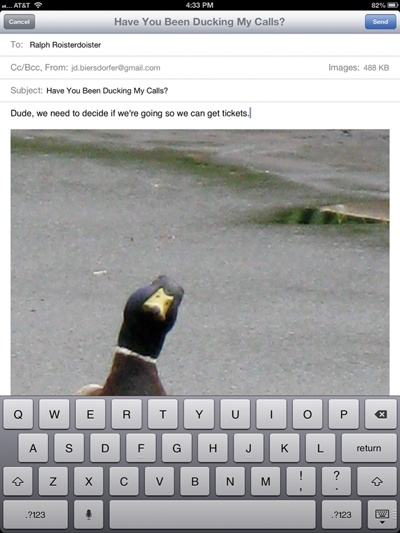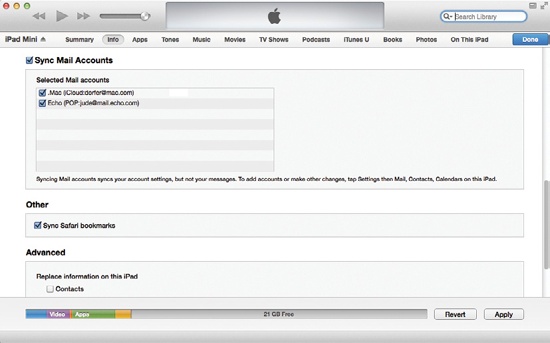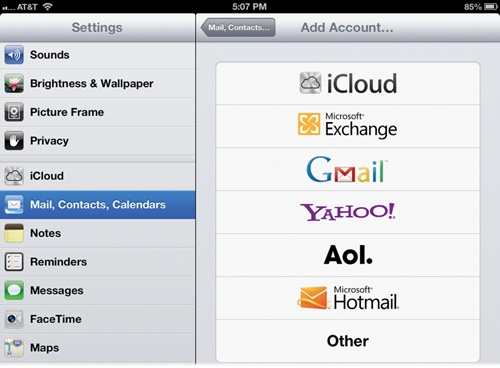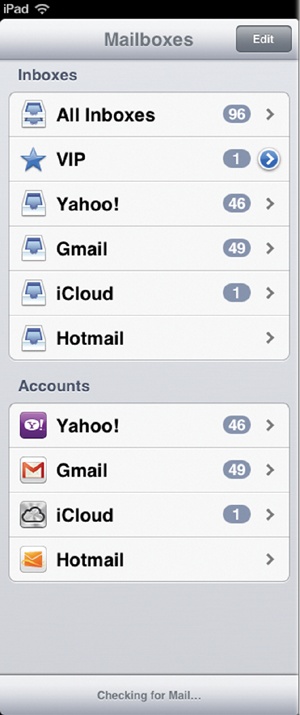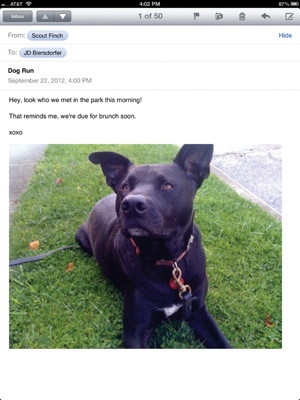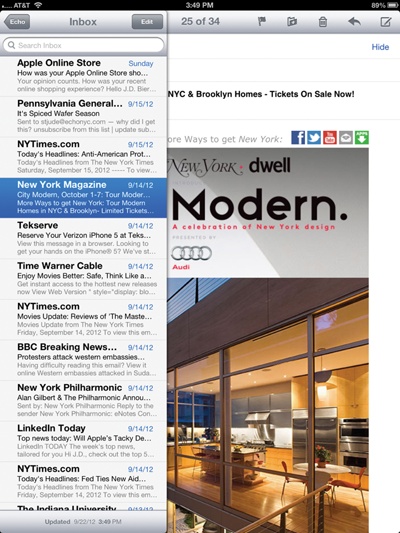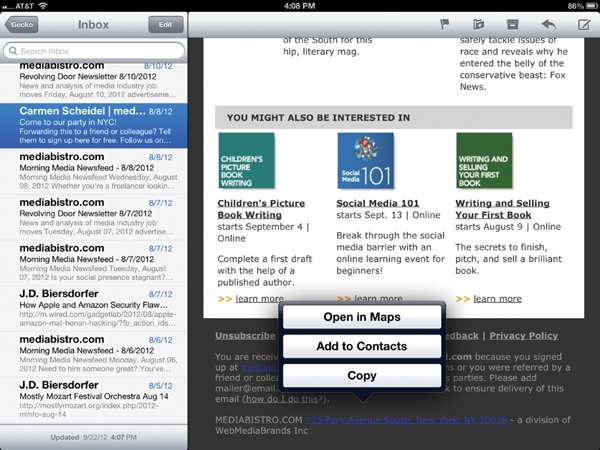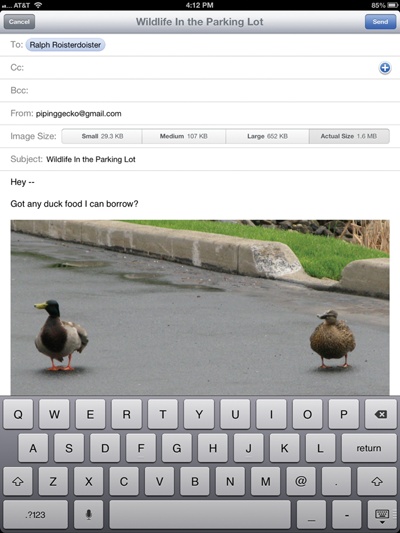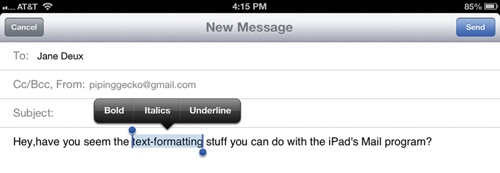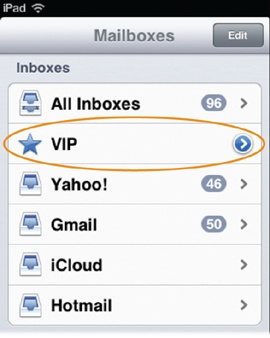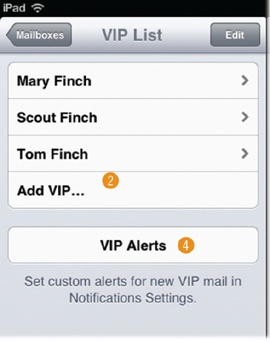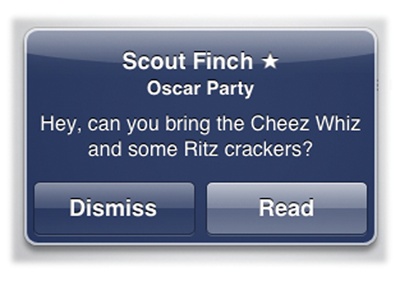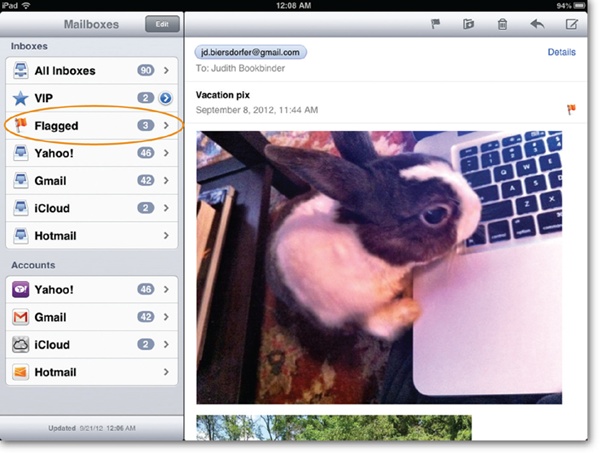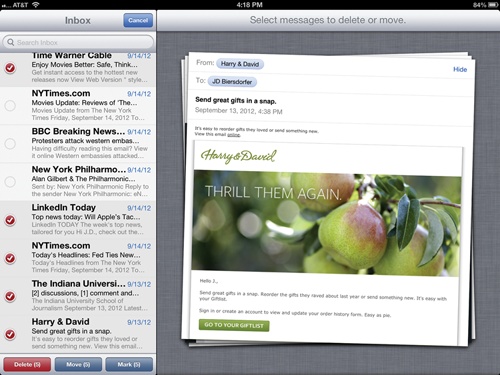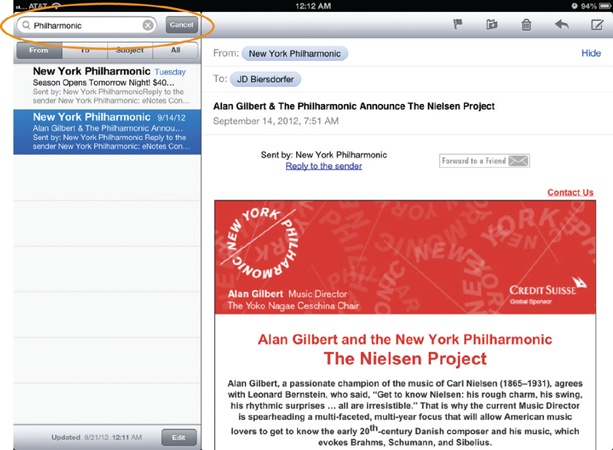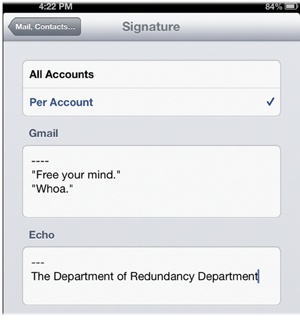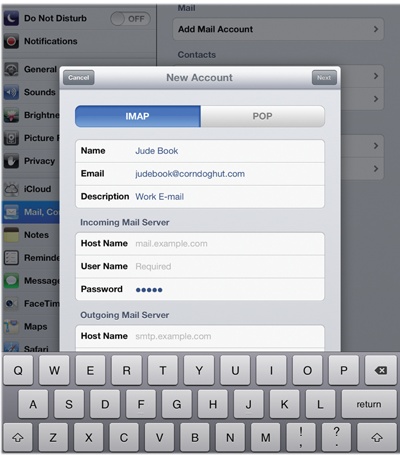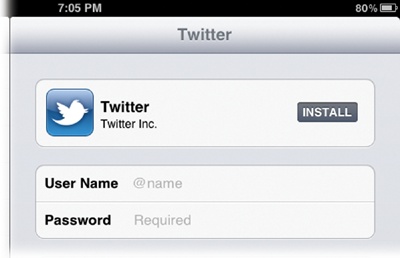Chapter 6. Keep in Touch with Email and Messaging
You’ll learn to:
Send and receive email from all your accounts
Set up the new VIP and Favorites mailboxes
Send text messages with Apple’s free service
Tweet from the slew of apps that now support Twitter
EMAIL IS PART OF your everyday life, and being able to compose, send, and receive mail on your smartphone means you can be on the go and still stay in touch, even if you have to hunch over a Lilliputian keyboard, squinting and pecking on a tiny screen.
The iPad changes all that. Now, you can lean back on your couch, flip on the tablet, and read and write mail on a spacious 8- or 10-inch screen. No more terse, abbreviated messages inspired by a cramped keypad.
This chapter gives you a tour of the iPad’s email program, from setting up your mail accounts to hitting the Send button on that first message.
And if email doesn’t give you the immediate gratification you seek for your communication needs, the iPad comes equipped with Messages, the app that works with Apple’s free iMessage service, so you can instantly send text, photos, and videos to other iOS users. The iPad also integrates Twitter, the ubiquitous microblogging service, into many apps, so you can instantly update friends on your shenanigans.
Then, when you finish this chapter and send out your screeds, you can enjoy the iPad’s other charms with just a tap—ebooks (Chapter 9), music (Chapter 14), and that new blockbuster movie (Chapter 15).
Set Up an Email Account (or Two)
THANKS TO ITS WIFI or Wi-Fi + Cellular connectivity, the iPad can grab your email out of thin air. You can read, write, and send messages to stay in the digital loop of your life.
But to get messages flowing into your iPad, you need to set up your email accounts so your tablet knows where on the Internet to look for your mail.
Copy your Desktop Mail Settings Using iTunes
You get email on your desktop or laptop computer, right? If you use a dedicated program like Microsoft Outlook or Apple Mail, you can copy your account settings over to your iPad without having to fiddle with server addresses and other arcane tech matters.
To do that, connect your iPad to your computer (either by Wi-Fi Sync or USB cable), click its icon in iTunes, and then click the Info tab on the next screen. Scroll down and turn on the Sync Mail Accounts checkbox. Next, under “Sync selected mail accounts,” put a check in the box next to the accounts you want to use on your iPad. Click Apply or Sync to copy the settings—but not your computer-based messages—over to your iPad, where you can now check for new mail.
Tip
Need another email address? You can get one from Apple when you sign up for a free iCloud account (Chapter 17). Your address will be [your name]@icloud.com. People who formerly had MobileMe accounts get a [your name]@me.com address as well.
Set Up Mail Accounts on the iPad
To manually set up an email account, first tap the Mail app on the iPad’s Home screen. If you use iCloud (Set Up iCloud on Your iPad), Microsoft Exchange, Gmail, Yahoo, AOL, or Hotmail, tap the appropriate icon on the next screen. If not, tap Other. Then:
On the next screen, type in your name, email address, password, and a nickname the iPad will use to identify your account (“Personal Gmail,” say). If you tapped Other, be prepared to peek at the account settings in your desktop computer’s mail program or to type in the settings you got from your Internet service provider (ISP) when you signed up for your account. You’ll need your user name, password, and the addresses of your ISP’s incoming and outgoing mail servers (which usually look something like mail.myserver.com and smtp.myserver.com, respectively).
If you don’t know the server addresses off the top of your head and can’t find the paperwork from your ISP, check the support area of its website for “email configuration settings” or “email server addresses.” (See POP3 and IMAP Accounts on the iPad for detailed steps on configuring ISP email.)
Click Save, and the mail program goes out and gets your new messages. Repeat the process if you have more than one account. (You can add more accounts later at Settings→Mail, Contacts, Calendars→Add Account.)
If you do have more than one email account, the iPad offers a unified Inbox at the top of the Mailboxes panel, as shown on the right. This means you can see all your new messages for every account just by tapping All Inboxes.
Of course, you can check each Inbox individually, too, by tapping the email account’s nickname. To see other folders for that account, like Sent, Trash, and Drafts, flick down to Accounts, tap a name, and then tap the name of the mailbox you want to see.
Tour the Mail Program
ONCE YOU SET UP your accounts, the iPad’s email program works pretty much like any other: You read messages, write messages, and send messages. But instead of popping open overlapping windows for each message you read and compose, the iPad keeps things in tight formation.
You don’t have to click a thing to see an account’s inbox on the left side of the screen and an open message displayed alongside it: Just hold your iPad horizontally. Your inbox appears as a list of messages, showing the sender’s name, the email’s subject, and a two-line preview of each message (below). To check for new messages, place your finger on the Inbox column and pull down. A search box lets you scan your mail for keywords. Here are a few other tips for iPad Mail:
A blue dot (
 ) next to a message preview means you haven’t
read it yet.
) next to a message preview means you haven’t
read it yet.A numerical gray icon on the right side of a message preview (
 ) refers to the number of messages in that
thread, or set of messages grouped together
because they share the same subject line.
) refers to the number of messages in that
thread, or set of messages grouped together
because they share the same subject line.Tap a message preview to see the missive open and fill the rest of the screen, complete with header, text, and attachments (see below).
To reply to a message (or forward it), tap
 . This brings up a fresh mail message with a
copy of the original below it, ready for you to annotate and send
off—or to fill out with a new address and forward along. It also
brings up the iPad’s virtual keyboard for the heavy
fingerwork.
. This brings up a fresh mail message with a
copy of the original below it, ready for you to annotate and send
off—or to fill out with a new address and forward along. It also
brings up the iPad’s virtual keyboard for the heavy
fingerwork.
If you find the Inbox screen a little too busy with previews and panes, hold the iPad vertically. This 90-degree move reorients the screen—all the background boxes disappear, and the one message you need to deal with sits front and center, filling the screen, with a toolbar on top.
This streamlined toolbar doesn’t have a lot of room for labels, so here’s a guide to the runes, generally moving from left to right along the screen:
 ,
,  (Previous Message, Next
Message). When you have a message open on-screen, you don’t
have to switch back to the Inbox view to open the next message (or
to go back to the previous one). Just tap the
(Previous Message, Next
Message). When you have a message open on-screen, you don’t
have to switch back to the Inbox view to open the next message (or
to go back to the previous one). Just tap the  button to move on to the next message or
button to move on to the next message or
 to revisit the previous message.
to revisit the previous message. (Flag
Message). Tap here to see a two-item menu. You can either
mark a message with a flag so you remember to return to it, or mark
it as unread so the message appears fresh and unopened the next time
you check your mail.
(Flag
Message). Tap here to see a two-item menu. You can either
mark a message with a flag so you remember to return to it, or mark
it as unread so the message appears fresh and unopened the next time
you check your mail. (Move to
Folder). Want to save an open message to a different folder
(Drafts, say) within an account? Tap this icon and pick the new
folder.
(Move to
Folder). Want to save an open message to a different folder
(Drafts, say) within an account? Tap this icon and pick the new
folder. (Delete). Tap
here when you’re done with a message for good—or if it was an
annoying piece of spam to begin with.
(Delete). Tap
here when you’re done with a message for good—or if it was an
annoying piece of spam to begin with. (Forward, Reply,
Print). When you want to respond to a message, send it along
to another recipient, or print it, tap
(Forward, Reply,
Print). When you want to respond to a message, send it along
to another recipient, or print it, tap  and choose an action from the drop-down menu.
(See Print with Your iPad for information on
setting up the whole print-right-from-my-iPad thing.)
and choose an action from the drop-down menu.
(See Print with Your iPad for information on
setting up the whole print-right-from-my-iPad thing.) (Compose New
Message). Need to fire off a fresh note to somebody? Tap here
to get started with a brand-new, blank message.
(Compose New
Message). Need to fire off a fresh note to somebody? Tap here
to get started with a brand-new, blank message.
The Mail app condenses email addresses down to just names in a blue oval. To see the person’s actual return address, tap the name to open the Sender info box. That same box gives you the option to send a text message (Send Messages) or to start a FaceTime chat (Make Video Calls with FaceTime).
Read Mail
SO HOW DO YOU read your mail once you get your accounts all set up? Like this:
Tap the Mail icon on the iPad’s Home screen. Unless you moved it, it’s in the bottom row of icons, between Safari and Photos.
If you’re connected to the Internet, the iPad checks all the email accounts you set up and downloads any new messages it finds. Tap an account name or All Inboxes under Inboxes.
If you hold the iPad horizontally (landscape mode), your Inbox sits on the left side of the screen. Tap a message preview to see the message in full on the right. If you hold the iPad vertically (portrait mode), the first or currently selected message fills the window; tap Inbox in the upper left to see what other messages await you. You can also swipe your finger left to right along the left edge of the screen to open the Inbox panel; swipe right to left, or tap the message on-screen, to hide the panel. If you’re in a folder for a specific email account, like Gmail’s All Mail folder, tap the account name (Gmail here) in the upper-left corner to see that account’s individual folders (Drafts, All Mail, and so on).
Work your way through your mail, either by tapping the message previews in the Inbox or using the
 and
and  buttons (Tour the Mail Program) to scoot up and down the list.
For a message you need to ponder later, tap the flag icon
(
buttons (Tour the Mail Program) to scoot up and down the list.
For a message you need to ponder later, tap the flag icon
( ) in the toolbar to flag it or mark it as
unread (see Flag Messages for Later).
) in the toolbar to flag it or mark it as
unread (see Flag Messages for Later).
File Attachments
Email messages sometimes come with files attached. The iPad can open and display Microsoft Office and iWork files. It can also handle PDF, RTF (rich text format, a cross-platform text standard), .vcf (a Contacts file standard), and text (.txt) files, as well as several photo and graphics file types, along with some types of video and audio files (as long as they aren’t copy-protected).
File attachments like photos usually appear open and visible in messages, so if someone sends you a few snaps from their vacation on Italy’s Amalfi Coast, you don’t have to hunt around for icons at the bottom of the message—you get instant envy without any extra effort.
Other attachments—like word-processing documents, spreadsheets, and presentations—do appear as icons at the bottom of a message. Tap that Excel chart icon, for example, and the whole spreadsheet pops open to fill the screen.
Use Information in Mail Messages
Ever notice how a lot of email messages involve setting up dinner dates, appointments, meetings, and other gatherings that use addresses and people’s contact info? The Mail app knows this—and is ready to do something about it.
Say you get an email suggesting dinner at a new restaurant—with the address helpfully pasted in the message. If it’s an unfamiliar location, press down on the address. The iPad recognizes this as a street address and turns it into a link. Tap it, and a box pops up offering four options—including the ability to see the address highlighted in the iPad’s Maps program. Now that’s service!
The other helpful options include:
Add to Contacts. If your sender includes personal information in a message, like a name, address, or phone number, you can add him or her to your Contacts list with a tap. When you choose this option, the iPad asks if you want to create a new contact using the included info or add that info to an existing file in your Contacts app (Use Information in Mail Messages).
Copy. Need to move this information into another message or program? Select Copy and, when you get to the destination program, hold your finger down and select Paste from the pop-up menu.
Event. If the message has an underlined date, time, or phrase (“dinner tomorrow”), press and hold that bit of text. You get menu options to create a new event, highlight the date in the iPad’s Calendar app, or copy the text.
Now that you’ve mastered reading email, turn the page to find out how to write and send messages.
Write and Send Email
WHEN YOU’RE READY TO write—or write back—the iPad is there for
you. To start from scratch with a new message, tap ![]() at the top of the screen. If you’re replying to
(or forwarding) a message, tap
at the top of the screen. If you’re replying to
(or forwarding) a message, tap ![]() and select Reply, Reply All,
or Forward. Either way, you create a new
message.
and select Reply, Reply All,
or Forward. Either way, you create a new
message.
If this is an unaddressed message, tap the To field at the top. The iPad keyboard appears. If the recipient is in your Contacts list (Use Twitter) or you’ve written to the person before, the iPad suggests addresses as you type, and, on your tap, fills in the line. (When you’re up in the header, you can also tap the
 button that magically appears under Send to
pop open your Contacts list.) Filling in the “Cc” (carbon copy)
field works the same way. If you’re replying to a message, the
address or addresses of your correspondents are already in place for
you. You can also drag addresses from the “Cc” field to the To field
with your finger.
button that magically appears under Send to
pop open your Contacts list.) Filling in the “Cc” (carbon copy)
field works the same way. If you’re replying to a message, the
address or addresses of your correspondents are already in place for
you. You can also drag addresses from the “Cc” field to the To field
with your finger.Tap the Subject line and type in whatever this message is about. If you’re replying to a message, you can tap and edit the Subject line using the handy delete key on the iPad keyboard.
Tap the message body area and type your missive.
If you have multiple mail accounts, tap the From field and choose the account you want to use here. Or set a default at Settings→Mail, Contacts, Calendars→Default Account.
When you finish, tap Send in the top-right corner. Hit Cancel (and then Delete Draft) if you change your mind about the whole thing.
Add Picture and Video Attachments to Mail Messages
One of the more popular uses of email (besides the sending and unfortunate receiving of spam) is as a delivery mechanism for pictures and videos. Images of grandkids, puppies, and kittens fill the Internet. If the photo or video is in your iPad’s Photos app, you can mail it. (See Chapter 16 for more on shooting, syncing, and storing photos on your iPad. Chapter 15 tells you how to have the same kind of fun with videos.)
For iPads running iOS 5 and later, bop into the Photos app from
the Home screen and tap open the album containing the image or images
you want to send. Tap ![]() at the top of the screen and then tap the
photos you want to mail to select them. Finally, tap the Share button
to create a new message with the images attached.
at the top of the screen and then tap the
photos you want to mail to select them. Finally, tap the Share button
to create a new message with the images attached.
If you have iOS 6, there’s a much easier way to stick a photo on an outgoing message—even if you’ve already started the message. With the message open, press your finger on the screen in the place where you want to add the video or photo. A menu like the one below appears. Tap “Insert Photo or Video.”
A box with your Camera Roll and other photo albums appears. To select a photo or video you’ve shot with your iPad, tap Camera Roll, and then tap the thumbnail of the image or clip you want to attach. Confirm this is the item you want and tap the Use button in the top-right corner to attach it.
Once you have an image (or images) attached to a message, you can adjust the size of the attachments if you don’t want to send giant files. Just tap Images in the message header. The Image Size options appear (shown on the opposite page) so you can choose a file size (Small, Medium, Large, or Actual Size). Tap one, finish writing your message, and then tap Send to fire it off.
If you already have a message started, you can paste in a pic; see Cut, Copy, Paste, and Replace Text.
Format Your Messages
THE ORIGINAL VERSION OF the iPad’s mail program was perfectly fine for composing, sending, and receiving mail. As email programs go, though, it was a little bland in that plain-text sort of way. Luckily, in iOS 5 and later, things have changed for the better.
You can now dress up your messages with bold, italic, or underlined text. This is helpful when you want to emphasize certain words in your message. Using type styles, you can also make long list-y things (like outlines) easier to read by using bolded and underlined text to break sections into subsections.
To format a message you’re composing, tap the word you want to jazz up, and then tap Select to highlight it. To format a phrase, tap a word in it, choose Select, and then drag the blue dots in either direction to highlight the words you want to include. To format an entire message (and really annoy your recipients), select a word and then tap Select All. Once you have your text selected, tap the highlighted area.
A long menu offering a variety of mail-editing commands appears. Your choices are Cut | Copy | Paste | Suggest… | B/U | Define | Insert Photo or Video | Quote Level. Tap the B/U option toward the center of the menu bar to reveal the full formatting menu, with the bold, italics, and underline options at your fingertips.
Tap the style you want. You can use more than one at a time, so feel free to knock yourself out with underlined bold italic text. Tap the message body to go back to your note.
Remember that Quote Level option at the end of the first menu bar?
Tap it to increase or decrease the indentation of text you select. For
example, to set off a paragraph in a message you’re writing, highlight
the text with the selection methods described above, tap
![]() in the pop-up menu bar, and then tap Quote Level.
Here, you can select Increase to add levels of indentation—and change
the color of the text with the first three indents. Tap Decrease to
remove the indents on the selected text, level by level.
in the pop-up menu bar, and then tap Quote Level.
Here, you can select Increase to add levels of indentation—and change
the color of the text with the first three indents. Tap Decrease to
remove the indents on the selected text, level by level.
Set Up a VIP Mailbox
EMAIL IS A GREAT way to exchange information, but it’s easy to get overwhelmed with finding the messages you want among the spam, newsletters, and other stuff in your mailbox. Wouldn’t it be great if the iPad would notify you when someone you want to hear from zaps you a note?
In iOS 6, this dream comes true. Thanks to the VIP Mailbox feature baked into the latest version of the iPad’s Mail app, you can set up a list of all the important people in your life—spouse, offspring, parents, business partners, Amazon customer service—and have the iPad collect those messages in the VIP mailbox and notify you (Use Notifications) when they arrive.
Here’s how to set up a VIP Mailbox:
Open the Mail app and tap VIP in the Mailboxes list in left column (circled).
Tap Add VIP.
When your Contacts list appears, flick around and tap the names of the people you want to assign VIP status.
To have the iPad alert you when one of your VIPs has dropped you a line, tap VIP Alerts. This takes you to the Notifications settings. Next to Notification Center, tap the On button and choose an alert style (discreet screen-top banners or middle-of-the-screen alerts like the one shown at left). Choose what kind of sound you want the iPad to play, if you want to see a message preview, and if you’d like the notification to show up on the iPad’s Lock Screen as well. (Use Notifications has more about configuring Notifications for iPad apps.)
Now, whenever one of your VIPs sends you a message, it arrives in
style and with a star (![]() ). To add new VIPs to your list, tap
). To add new VIPs to your list, tap
![]() in the VIP Inbox, and then tap Add VIP on the
next screen. You can remove people by tapping open the VIP list, hitting
the Edit button, and then tapping
in the VIP Inbox, and then tap Add VIP on the
next screen. You can remove people by tapping open the VIP list, hitting
the Edit button, and then tapping ![]() next to The Unworthy.
next to The Unworthy.
Flag Messages for Later
AS YOU BROWSE YOUR list of new mail, you may see those types of messages. You know, the ones you need to reply to at some point but can’t deal with right now—though you don’t want to forget about them, either.
The Mail app gives you a couple of ways to defer your attention. You can flag certain messages, which makes them stand out in the Inbox with a snappy orange flag. Or you can mark messages as unread, which restores their blue “unread” dot and makes them seem like new messages all over again, sure to catch your eye when you finally have time to sit down and craft a reply. Here’s what to do for:
One message. If you have the message open on-screen, tap the flag icon (
 ) at the top of the Mail window. Select Flag
or Mark as Unread from the menu that drops down.
) at the top of the Mail window. Select Flag
or Mark as Unread from the menu that drops down.Multiple messages. If you’re cruising down your list of message previews in the Inbox pane and see several pieces of mail you want to flag or mark as unread at once, tap the Edit button at the top of the column. Tap each message you want to either flag or mark as unread, and then tap the Mark button at the bottom of the screen. Choose Flag or Mark as Unread to change all the selected messages.
If you already have a message flagged and you hit the Flag/Mark
menu, you get the option to unflag the item and
remove its Marker of Importance. Likewise, if you have mail you haven’t
read—and you don’t want to read—the menu gives you
a “Mark as Read” option. Tapping it whacks the blue “unread” dot
(![]() ) from your message so it sinks back into the pile
of mail you’ve already read.
) from your message so it sinks back into the pile
of mail you’ve already read.
The Flagged Mailbox
Those snappy orange flags do a good job of making those deal-with-me-later messages stand out in your mailbox, but what if you have a ton of messages in your Inbox—do you really want to scroll up and down the list looking for that one flag in the bunch? Or maybe you have multiple mail accounts and can’t remember where you planted the flag about that upcoming meeting.
In iOS 6, the iPad gives your flagged messages a whole mailbox of their own. It’s like a To Do List for messages that need responses.
You don’t see the Flagged mailbox (circled below) until you stick that first flag on a message. But once you do, it pops up proudly in your iPad’s Inbox panel, right under your VIP list (Set Up a VIP Mailbox). It even displays the number of messages in the box, so you know how much coffee to get before you settle down to reply.
When you unflag or delete the last message in the list, the Flagged mailbox disappears from view—only to return when you let your mail flag fly once again.
Manage Your Email
EMAIL CAN PILE UP quickly, especially if you have several accounts funneling mail into your tablet. If you find yourself splashing around in a rising tide of mailbox flotsam, here are a few things you can do to get your mail back under control:
Delete all the junk at once. Zapping unwanted messages out of your Inbox one by one with a finger swipe is tedious. Happily, there’s a faster way. Tap the Edit button at the top of the Inbox pane. Buttons to delete, move, and mark mail appear at the bottom of the screen (below). In the message list, tap the ones you want to either nuke or refile (there’s more on the Mark button below). Each message you select slides out into a “pile” next to the Inbox list—these are readable versions, so you can make sure you aren’t dumping anything you still need.
Once you make your selections, tap the appropriate button to send all those messages to the same place at once—either the trash or to a different folder.
File messages in different folders. Some mail providers, like Yahoo and AOL, let you create your own folders to sort messages the way you prefer, like by topic or sender. If you had your own folders set up with the service before you got your iPad, the folders should be there after you add the account to your tablet. To file a message into one of these personal folders, tap the
 icon and choose the folder you want.
icon and choose the folder you want.Make new mailbox folders on the iPad. If you need still more places to sequester messages, you can create new mailbox folders right on the iPad. Just go to the mail account’s main screen (the one showing all its mailboxes) and tap the Edit button in the top-right corner. On the Edit screen, tap New Mailbox. On the screen that appears, give the new mail folder a name (“Work Stuff” or “Kitchen Renovation Project”). Tap the Mailbox Location line to choose a destination for the new folder, like alongside your other mail folders or within another existing mail account altogether. Tap Save when you finish. Now you have a new folder in which to file your mail. To delete a mailbox, tap Edit from the account’s main screen, and then tap the folder you wish to remove. On the next screen, tap Delete Mailbox.
Scan for spam. Want to see the messages that are personally addressed to you, either in the To or Cc fields—and not mail addressed to you and 500 other people from bulk mailing lists or junk-mail dealers? The iPad can identify your personal messages by sticking a distinct little
 or
or  tag on them. To turn on the tags, choose
Settings→Mail, Contacts, Calendars and then flip the On switch next
to Show To/Cc Label. Messages without these tags stand out and make
more obvious targets for the mass-deletion method described above.
(The next page has more adjustments you can make to the Mail
program’s settings.)
tag on them. To turn on the tags, choose
Settings→Mail, Contacts, Calendars and then flip the On switch next
to Show To/Cc Label. Messages without these tags stand out and make
more obvious targets for the mass-deletion method described above.
(The next page has more adjustments you can make to the Mail
program’s settings.)Search your mailboxes. Need to find a particular message buried deep within your mailbox? Tap open the mailbox you want to scan and in the search box at the top of the column, type in the keywords for the message you want to find. You can search by sender, recipient, subject, or by the text in the message. After you enter your keywords, tap the Search button on the keyboard to see all the messages that match your terms. If you use a mail account that stores messages on a server (like IMAP accounts, as POP3 and IMAP Accounts on the iPad explains) and your search comes up empty, tap “Continue Search on Server…” to sift through messages that may not be on your iPad anymore, but are still stored on your ISP’s email server.
Adjust Mail Settings
LIKE MOST PROGRAMS, THE iPad’s mail app comes with standard settings for things like the size of the text that appears on-screen. If you don’t like the way the type looks or you want to tweak the program in other ways (like how many lines of a message appear in the Inbox preview), take a trip to Home→Settings→Mail, Contacts, Calendars. From here, you can:
Change the minimum font size. Unlike paper mail, you can easily make the message text bigger or smaller. In iOS 6, go to Settings→General→Accessibility and pick a new text size.
Add a custom signature. You can add a personalized tag to the bottom of each outgoing message, with a different one for every mail account. Popular signatures include your contact information, Twitter handle, or quotes from The Matrix.
Show more (or less) preview in your message list. Out of the box, the iPad’s mail program shows you a two-line preview of each message so you have some idea of what it contains. You can change this to one to five lines, or select None to turn off the preview entirely.
Set a default mail account. If you have multiple email accounts on your iPad, use this setting to designate one of them as your default account for all outgoing messages (and for messages you create by tapping mail links in other programs). Remember, you can still tap the From field to switch to a different account on the fly.
Load remote images (or not). Some people don’t like embedded graphics in a message, as they can transmit a signal to the sender that you opened the message. Turn off images here.
Organize by thread. Hate threaded messages clumped together under one subject line? Turn it (and those
 icons) off here.
icons) off here.Increase quote levels. Mail indents sections of the original message when you reply to it. If you hate that indenting stuff, turn it off here.
Delete unwanted mail accounts. Need to ditch an account because it’s become too spam-laden or you want to streamline things? Flick up to the Accounts section, tap the name of the doomed account to get to its settings, and then tap Delete Account.
Webmail On the iPad
DESPITE THE FACT THAT you can get your messages on your iPad through its dedicated Mail app, that’s not the only way to monitor your inbox. As you may remember from the last chapter, the iPad has a nice, sturdy web browser. With it, you can check web-based email accounts (Gmail, Yahoo, AOL, Hotmail/Outlook.com, and so on) by logging in through Safari. The beauty of webmail is that you can manage your email from whatever Internet-ready device you happen to be using that day.
Depending on the email service you use, you may find that it offers a mobile version of your mailbox when you log in through the iPad’s browser, like the Outlook.com mailbox shown here. Some services (like Google) even have their own free apps in the App Store, designed to make it easier to check mail, news, and other features on your iPad. Run a search in the App Store for your service.
Note
To help you keep a copy of each message in your account no matter where you read it, Gmail turns the Delete button into an Archive button when you try to zap a Gmail message from the iPad. Instead of deleting the message from your inbox, Gmail moves it into the All Mail area of your account, where you can still read it on the Gmail website or on other devices you use for Gmail. If you prefer to delete those unwanted messages, tap Settings→Mail, Contacts, Calendars, and then tap the name of your Gmail account. In the account’s settings area, tap the button next to Archive Messages to Off.
POP3 and IMAP Accounts on the iPad
WEB-BASED MAIL—ESPECIALLY IF IT’S free—works for many people. But millions of others don’t use it, perhaps because they have accounts from their Internet service providers, use employer-provided accounts, or worry about privacy and security. These mail accounts are typically one of two types:
POP accounts. Short for “Post Office Protocol,” these accounts use common, but older messaging technology that pre-dates the mobile boom.
POP’s main drawback is that it wasn’t designed for checking mail from more than one computer. Unless your ISP allows you to save mail on its server, POP servers transfer incoming messages to your computer (including your iPad) before you read them, which works fine as long as you use only that machine for email. You won’t get those messages when you log in from another device because you already downloaded them. If your ISP’s server lets you save messages, though, it’s not a problem.
IMAP accounts. IMAP (Internet Message Access Protocol) is a newer mail system that folks on the go tend to like much better than one-stop POP. Instead of downloading a message to just one machine and leaving it there, IMAP servers keep all your mail online. That means you can get the same mail from any computer (or trusty iPad) you use. These thoughtful IMAP servers remember which messages you’ve read and sent off. They also keep tabs on your other mail folders. (iCloud, Gmail, Yahoo, and AOL all use IMAP, as do corporate Microsoft Exchange servers.)
Now for the bad news: Since all this mail roosts on an IMAP server, you need to deliberately delete old messages or your mailbox will eventually runneth over. On IMAP accounts that don’t come with a lot of storage, the server could start bouncing new messages when it gets full, annoying your friends. And you don’t want that.
No matter which kind of account you have, the iPad will work with it. You just need to have all the account information on hand. Syncing your mail accounts with iTunes (described on Set Up an Email Account (or Two)) is one way to get each type of account set up correctly on the iPad. If you skipped that step, you can do it the old-fashioned, manual way.
Tip
The iPad generally copies your IMAP messages to itself, so you can deal with mail even when you’re not online. If you want to direct these messages to a specific mail folder, you can. Open Settings→Mail, Contacts, Calendars→[IMAP account name]→Account→Mail→Advanced. On this screen, tell the iPad where to put draft, sent, and deleted messages.
Here’s how you manually add that account to the Mail app:
Start on the iPad’s Home screen and tap Settings→Mail, Contacts, Calendars→Add Account.
On the next screen, tap Add Mail Account, and then enter your name, email address, password, and an optional description.
Tap Next to start working through the account-creation screens.
The Mail app attempts to pin down which kind of account you have (POP or IMAP) by your email address. If it can’t figure that out, it takes you to a second screen and grills you for information, like the host name for incoming and outgoing mail servers. At the top of the box, tap either IMAP or POP to inform the iPad of your account type. (If you don’t have this information written down or stored in your own memory bank, take a minute now and ask your Internet service provider or the office tech guru for help.)
If all the information you tapped in was correct, your account should be configured, and the iPad should be fetching your messages now.
Send Messages
THANKS TO APPLE’S IMESSAGE service and its Messages app in iOS 5 and later, iPad owners now have a way to send unlimited, free text messages, photos, videos, and more to people who are also running Messages on their iPads, iPhones, and iPod Touches. There’s even a version for Mac OS X Lion (and later). And the iMessage service works over a WiFi, 4G, or 3G connection. Setting up Messages takes just a few steps:
On the Home screen, tap open the Messages app. The first time you start it up, it asks you to enter your Apple user name and password. (If you blew off Apple’s previous 36 attempts to get you to sign up for an Apple ID, tap Create New Account and follow along on-screen.) The email address you use with your Apple ID is the one people need in order to communicate with you over the iMessage network.
To add additional email addresses to your Messages account, tap open the Settings icon on the iPad’s Home screen and, in the left column of icons, tap Messages. Tap the Receive At line, and then type in more addresses. (As shown below, the Settings screen also has a button to completely turn off the iMessage service for those times when you don’t want to be pestered with message alerts popping up constantly.)
Once you sign up, you can send messages to others who have registered with Apple. Tap open the Messages app on the Home screen, tap the
 icon, and then enter the address of your
recipient; you can also tap the
icon, and then enter the address of your
recipient; you can also tap the  icon to open your Contacts list and pick a
name from there. Type your message in the text field (circled on the
opposite page) and then tap Send. Tap the
icon to open your Contacts list and pick a
name from there. Type your message in the text field (circled on the
opposite page) and then tap Send. Tap the  icon to send a pic or video from your
Camera Roll album or to shoot a pic or a video clip
now.
icon to send a pic or video from your
Camera Roll album or to shoot a pic or a video clip
now.
Your previous Messages appear in a list on the left side of the screen, and you can restart a conversation by tapping one open. Here’s what the more common icons on the Messages screen mean:
A blue dot (
 ) next to a name means you have unread
messages.
) next to a name means you have unread
messages.A red exclamation mark means the iPad encountered a problem sending your message—or with the recipient’s address. Check your connection and Contacts list.
Tap
 and then tap a photo, video, or message
within the conversation to forward that part on to someone else—or
to delete it from the chat.
and then tap a photo, video, or message
within the conversation to forward that part on to someone else—or
to delete it from the chat.To whack entire conversations, tap the Edit button, select the unwanted messages, and then tap Delete (
 ).
).To dismiss the keyboard so you can see more of the screen, tap the
 key in the keyboard’s lower-right
corner.
key in the keyboard’s lower-right
corner.
Emoticons—those happy faces and other icons used in
text messages—also work with Messages. The iPad includes
an emoticon font called Emoji that lets you accent notes with graphics.
To use the font, you first have to assign it to a keyboard—see Use an International or Emoji Keyboard. Once you do, tap
![]() on the keyboard, select the Emoji font, and then
add some pixelated emotion (
on the keyboard, select the Emoji font, and then
add some pixelated emotion (![]() ) to your notes.
) to your notes.
Note
Because the iMessage service is linked to your email address and not to a particular device, you can start an iMessage on, say, your iPad, continue it on your iPod Touch, and finish it on your iPhone. You just need the Messages app on each gadget set up to work with the same email address (or addresses).
Use Twitter
TWITTER, FOR THOSE WHO haven’t been paying attention the past few years, is a “microblogging” service—it lets you update friends about your activities and musings. Millions of people use it to report what they see or feel, check for public announcements, and share links to photos and web pages. You have 140 typed characters per message to express your thoughts. And it’s free.
If you already have a Twitter account—and use it frequently to keep up with the world and your friends—get ready to let out a joyous virtual whoop, because the iPad lets you tweet (post updates) directly from many iPad apps, including Safari, Maps, YouTube, Camera, and Photos. Just log into your existing Twitter account at Home→Settings→Twitter. (Facebook works the same way in iOS 6.)
Technically, Twitter is not a built-in app, but so many iPad programs offer a tweet option that it’s best covered here. To get the full Twitter experience, where you can not only tweet from apps, but also read others’ posts and reactions to the things you share, you can install or activate the full Twitter app right from the iPad’s Settings screen:
Tap Home→Settings→Twitter.
Tap the Install button to snag a copy of Twitter from the App Store. (You need an App Store account and password to get the app—check out Set Up an Apple ID if you don’t have one.)
If you already have a Twitter account, type in your user name and password on the Twitter settings screen and then tap Sign In.
If you’re new to this Twitter thing but want to take the plunge right on your iPad, tap the Create New Account button and follow along.
So now that you have Twitter installed and your personal Twitter account set up, what do you do with it on your iPad? If you’re an experienced Twitter user, you’ve probably already put this book down and gone off to post a few tweets to your pals. If you’re brand-new to Twitter, read on.
First, you need to find some people on Twitter who you’d like to hear from on a regular basis. In Twitter lingo, that means you want to follow, or subscribe to, these Twitter users. They can be friends, celebrities, news organizations, government offices, or anybody else who signed up for Twitter. Once you elect to follow someone (or some group), Twitter sends you their updates as they post them. Collectively, Twitter calls these updates a timeline. To follow a Twitterer, you need to know the person or organization’s Twitter account name.
One way to find and follow someone is to tap the Search icon
(![]() ) on the left side of the screen, type in the
person’s Twitter name or a topic you’re interested in, and hit the
Search button on the keyboard. In the results list, tap the profile
photo of the person or group that interests you. This expands that
person’s (or group’s) profile page so you can find out more. Tap the
Follow button to add that person’s or group’s Twitter posts to your
timeline. (You can find out more about using Twitter at http://support.twitter.com/groups/31-twitter-basics.)
) on the left side of the screen, type in the
person’s Twitter name or a topic you’re interested in, and hit the
Search button on the keyboard. In the results list, tap the profile
photo of the person or group that interests you. This expands that
person’s (or group’s) profile page so you can find out more. Tap the
Follow button to add that person’s or group’s Twitter posts to your
timeline. (You can find out more about using Twitter at http://support.twitter.com/groups/31-twitter-basics.)
Other people can sign up to follow your
Twitter account as well, so it’s good to post a few messages here and
there for your subscribers. To fire off tweets from the Twitter app, tap
![]() in the lower-left corner, compose a thought, and
then tap Send in the upper-right corner. Your message soon appears in
the timelines of all your followers.
in the lower-left corner, compose a thought, and
then tap Send in the upper-right corner. Your message soon appears in
the timelines of all your followers.
The Twitter app has a row of other icons along the left side of the screen. Tap the house-shaped Home icon to flick down the list to see all the recent posts from people you follow. Tap a post to pop it out to a larger size for better readability. If someone tweets a web link, tap the URL to see the page on a new screen; you can see photos attached to tweets by tapping the post to expand it.
Tap the Connect (@) icon to see tweets that mention you by your Twitter handle, the Discover icon (#) to see posts Twitter thinks you may find interesting based on who you follow, and the little head icon to edit your Twitter profile page.
Want to tweet right from apps that support Twitter (like the ones
mentioned on the previous page)? Just tap ![]() to see if Tweet is an option in the drop-down
menu. You’ll find yourself sharing all sorts of things with the
class.
to see if Tweet is an option in the drop-down
menu. You’ll find yourself sharing all sorts of things with the
class.

